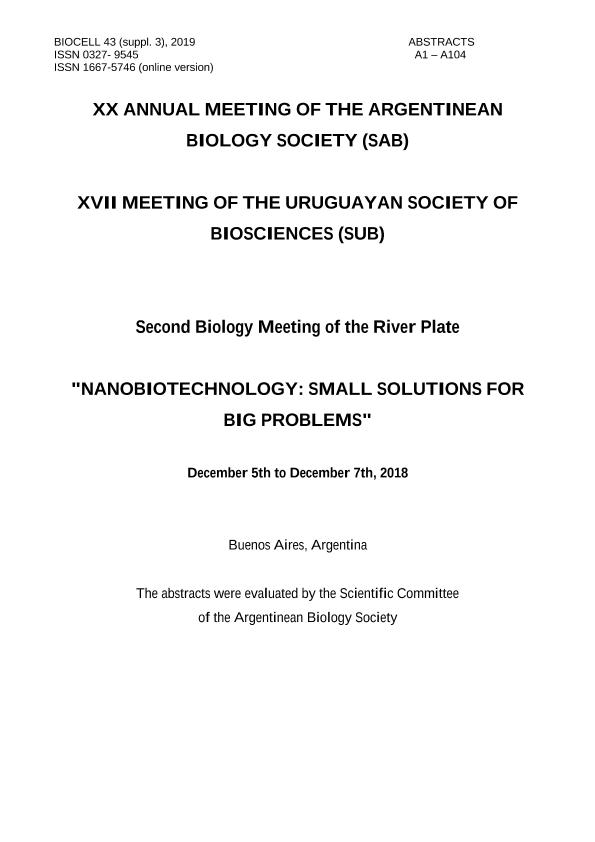Evento
Ionic dissolution products from bioactive glass-ceramic scaffolds 45S5.2B positively modulate the in vitro cell response under conditions of hyperglycemia
Haro Durand, Luis Alberto ; Baldi, Alberto
; Baldi, Alberto ; Fanovich, Maria Alejandra
; Fanovich, Maria Alejandra ; Boccaccini, Aldo Roberto; Gorustovich Alonso, Alejandro Adrian
; Boccaccini, Aldo Roberto; Gorustovich Alonso, Alejandro Adrian
 ; Baldi, Alberto
; Baldi, Alberto ; Fanovich, Maria Alejandra
; Fanovich, Maria Alejandra ; Boccaccini, Aldo Roberto; Gorustovich Alonso, Alejandro Adrian
; Boccaccini, Aldo Roberto; Gorustovich Alonso, Alejandro Adrian
Tipo del evento:
Jornada
Nombre del evento:
XX Jornadas Anuales de la Sociedad Argentina de Biología y XVII Jornadas de la Sociedad Uruguaya de Biociencias; Segundas Jornadas Rioplatenses de Biología
Fecha del evento:
05/12/2018
Institución Organizadora:
Sociedad Argentina de Biología;
Sociedad Uruguaya de Biociencias;
Título de la revista:
Biocell
Editorial:
Tech Science Press
ISSN:
0327-9545
e-ISSN:
1667-5746
Idioma:
Inglés
Clasificación temática:
Resumen
One of the main complications of diabetes mellitus (DM) is the failure in the process of tissue repair due to cellular dysfunction as a result of hyperglycemia. Under hyperglycemic conditions, the main cells involved in restoring the functionality and integrity of tissues are unable to migrate, proliferate, and secrete growth factors and components of the extracellular matrix, all of which is favored by altered mechanisms of glycation and oxidation. This alteration invariably contributes to failures in repair processes. Thus, it is of biomedical interest to study different therapeutic strategies to optimize the repair and/or regeneration of tissues under hyperglycemic conditions. These strategies may include the use of different biomaterials in the form of three-dimensional porous matrices, known as scaffolds. The ideal design of these scaffolds should provide temporary biocompatible mechanical support and positively modulate the cellular response. Since it has been established that boron (B) plays a role in angiogenesis and tissue repair, it can be expected that the controlled and localized release of B ions from the bioactive glass-ceramic scaffolds could represent a promising alternative therapy in regenerative medicine of vascularized tissues in patients with DM. The aim of this work was to study the in vitro cellular response of ionic dissolution products from bioactive scaffolds manufactured from the controlled crystallization of a 45S5 glass (% w/w composition: 45% SiO2, 24.5% Na2O, 24.5% CaO, and 6% P2O5) added with 2% of B2O3 (45S5.2B), in primary cultures of fibroblasts (HDF) and endothelial cells (HUVECs) grown in hyperglycemic conditions (30 mM D-glucose). The results demonstrated, for the first time, that the ionic dissolution products released from the 45S5.2B bioactive glass-ceramic scaffolds positively modulate the in vitro cellular response of fibroblasts and endothelial cells grown under hyperglycemic conditions. This was corroborated by an increased proliferative and migratory response, greater ability to form tubules in vitro and an increase in the secretion of growth factors. These findings may be relevant in vascularized tissue engineering since scaffolds obtained from the 45S5.2B bioactive glass could act as inorganic agents that positively modulate the cellular response and favor processes of tissue repair and/or regeneration in patients with DM.
Palabras clave:
BIOACTIVE GLASS-CERAMIC
,
SCAFFOLDS
,
BORON
,
HYPERGLYCEMIA
Archivos asociados
Licencia
Identificadores
Colecciones
Eventos(CCT - SALTA-JUJUY)
Eventos de CTRO.CIENTIFICO TECNOL.CONICET - SALTA-JUJUY
Eventos de CTRO.CIENTIFICO TECNOL.CONICET - SALTA-JUJUY
Eventos(IBYME)
Eventos de INST.DE BIOLOGIA Y MEDICINA EXPERIMENTAL (I)
Eventos de INST.DE BIOLOGIA Y MEDICINA EXPERIMENTAL (I)
Eventos(INTEMA)
Eventos de INST.DE INV.EN CIENCIA Y TECNOL.MATERIALES (I)
Eventos de INST.DE INV.EN CIENCIA Y TECNOL.MATERIALES (I)
Citación
Ionic dissolution products from bioactive glass-ceramic scaffolds 45S5.2B positively modulate the in vitro cell response under conditions of hyperglycemia; XX Jornadas Anuales de la Sociedad Argentina de Biología y XVII Jornadas de la Sociedad Uruguaya de Biociencias; Segundas Jornadas Rioplatenses de Biología; Buenos Aires; Argentina; 2018; 44-45
Compartir



